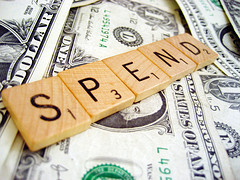 Spending money is a complicated subject in the minds of many Americans. Everywhere on the Internet you’ll find articles by wannabe pop psychologists explaining why people spend the way they do and how they could and should spend less … or differently … or something. Guilt, shame and entitlement are the used watchwords. Poppycock. It’s really quite simple. While the majority of consumers do give in to an occasional bout of retail therapy, only about 5% of the population can be labeled compulsive spenders, according to the Journal of Psychiatry.
Spending money is a complicated subject in the minds of many Americans. Everywhere on the Internet you’ll find articles by wannabe pop psychologists explaining why people spend the way they do and how they could and should spend less … or differently … or something. Guilt, shame and entitlement are the used watchwords. Poppycock. It’s really quite simple. While the majority of consumers do give in to an occasional bout of retail therapy, only about 5% of the population can be labeled compulsive spenders, according to the Journal of Psychiatry.
Most consumer spending is done for very healthy reasons, such as need, want and investment. When customers receive a high level of perceived value for their spending, their relationship with the retailer or service provider will be enhanced.
Need
John Lennon used to sing “All you need is love.” (Of course he had a fortune worth $800 million.) However, the average Joe or Jane can’t live on love alone but needs to spend money for life’s necessities. Food, clothing and shelter are considered basic needs in Western society, although the quality, amount and price tag attached to these items will vary widely depending on the individual doing the purchasing.
Want
In theory Betty Sue may only need one winter coat, but if she lives in a sophisticated urban area and/or works in the fashion or entertainment industry, she may find herself jonesing for another stylish wrap or two. Many purchases, from an upgrade to the latest smartphone to an exotic vacation, are made due to want, and if there are funds in the household budget for such splurges, “Why not?” tends to be the operative phrase governing such decisions.
Investment
Investment spending means laying out money now to obtain future value. This is the motivation for a wide variety of purchases (and the psychology behind customer loyalty programs) such as:
- ordering pizza for supper to save time for an important project
- putting down a large sum for a fine quality sofa which will have a longer lifetime than a less expensive piece
- paying for a more efficient HVAC system in order to improve quality of life and save on utility bills
- buying high ticket items like jewelry or real estate as a means of building up wealth – either to use during retirement or to pass on to one’s heirs eventually.
Perceived Value for Money
Whatever the item or service, financial savvy folks are reluctant to spend in ways they see as wasteful or “not worth it.” They are however, ready and willing to lay out hard-earned cash to receive perceived value, goods or services that deliver a real bang for one’s buck. Even the decision about which beverage to start the morning with is made on the basis of perceived value; a pricy designer coffee may give the caffeine addict more pleasure per dollar than the local diner’s brew. And if the barista gets your cappuccino to you in record time with a pleasant smile, that extra service will make the purchase even more satisfying.
Canny marketers know that the perception of value determines not only which of two items Carl Consumer will buy, but also his attitude and loyalty toward the seller. (See the 2008 study “Perceived value, customer attitude and loyalty in retailing” by Ruiz-Molina and Gil-Saura, published in the Journal of Retail and Leisure Property.) A more germane question for small businesspeople might be “Why Do People Spend Money on Particular Items and at Particular Enterprises?” This will encourage raising the perceived value of products and services, thereby increasing customer satisfaction and retention.
